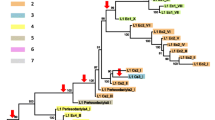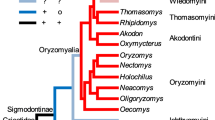Abstract
L1 elements are retrotransposons that have been replicating and evolving in mammalian genomes since before the mammalian radiation. Rattus norvegicus shares the young L1mlvi2 clade only with its sister taxon, Rattus cf moluccarius. Here we compared the L1mlvi2 clade in these recently diverged species and found that it evolved rapidly into closely related but distinct clades: the L1mlvi2-rm clade (or subfamily), characterized here from R. cf moluccarius, and the L1mlvi2-rn clade, originally described in R. norvegicus. In addition to other differences, these clades are distinguished by a cluster of amino acid replacement substitutions in ORF I. Both rat species contain the L1mlvi2-rm clade, but the L1mlvi2-rn clade is restricted to R. norvegicus. Therefore, the L1mlvi2-rm clade arose prior to the divergence of R. norvegicus and R. cf moluccarius, and the L1mlvi2-rn clade amplified after their divergence. The total number of L1mlvi2-rm elements in R. cf moluccarius is about the same as the sum of the L1mlvi2-rm and L1mlvi2-rn elements in R. norvegicus. The possibility that L1 amplification is in some way limited so that the two clades compete for replicative supremacy as well as the implications of the other distinguishing characteristic of the L1mlvi2-rn and L1mlvi2-rm clades are discussed.
Similar content being viewed by others
References
Adey NB, Schichman SA, Graham DK, Peterson SN, Edgell MH, Hutchison III CA (1994a) Rodent L1 evolution has been driven by a single dominant lineage that has repeatedly acquired new transcriptional regulatory sequences. Mol Biol Evol 11: 778–789
Adey NB, Tollefsbol TO, Sparks AB, Edgell MH, Hutchison III CA (1994b) Molecular resurrection of an extinct ancestral promoter for mouse L1. Proc Natl Acad Sci USA 91: 1569–1573
Ausubel FM, Brent R, Kingston RE, Moore DD, Seidman JG, Smith JA (1989) Current protocols in molecular biology. Wiley, New York
Cabot EL, Beckenbach AT (1989) Simultaneous editing of multiple nucleic acid and protein sequences with ESEE. Comput Applic Biosci 5: 233–234
Casavant NC, Hardies SC (1994a) The dynamics of murine LINE-1 subfamily amplification. J Mol Biol 241: 390–397
Casavant NC, Hardies SC (1994b) Shared sequence variants of Mus spretus LINE-1 elements tracing dispersal to within the last 1 million years. Genetics 137: 565–572
Casavant NC, Hardies SC, Funk FD, Comer MB, Edgell MH, Hutchison III CA (1988) Extensive movement of LINES ONE sequences in beta-globin loci of Mus caroli and Mus domesticus. Mol Cell Biol 8: 4669–4674
D’Ambrosio E, Waitzkin SD, Witney FR, Salemme A, Furano AV (1986) Structure of the highly repeated, long interspersed DNA family (LINE or L1Rn) of the rat. Mol Cell Biol 6: 411–424
Fanning T, Singer MF (1987a) The LINE-1 DNA sequences in four mammalian orders predict proteins that conserve homologies to retrovirus proteins. Nucleic Acids Res 15: 2251–2260
Fanning TG (1983) Size and structure of the highly repetitive BAM HI element in mice. Nucleic Acids Res 11: 5073–5091
Fanning TG, Singer MF (1987b) LINE-1: a mammalian transposable element. Biochem Biophys Acta 910: 203–212
Feinberg AP, Vogelstein B (1983) A technique for radiolabeling DNA restriction endonuclease fragments to high specific activity. Anal Biochem 132: 6–13
Felsenstein J (1993) PHYLIP (Phylogeny Inference Package). University of Washington, Seattle
Furano AV, Robb SM, Robb FT (1988) The structure of the regulatory region of the rat L1 (L1Rn, long interspersed repeated) DNA family of transposable elements. Nucleic Acids Res 16: 9215–9231
Furano AV, Usdin K (1995) DNA “fossils” and phylogenetic analysis. J Biol Chem 270: 25301–25304
Hardies SC, Martin SL, Voliva CF, Hutchison III CA, Edgell MH (1986) An analysis of replacement and synonymous changes in the rodent L1 repeat family. Mol Biol Evol 3: 109–125
Hattori M, Kuhara S, Takenaka O, Sakaki Y (1986) L1 family of repetive DNA sequences in primates may be derived from a sequence encoding a reverse transcriptase-related protein. Nature 321: 625–628
Hayward BE, Zavanelli M, Furano AV (1997) Recombination creates novel L1 (LINE 1) elements in Rattus norvegicus. Genetics 146: 641–654
Hohjoh H, Singer MF (1996) Cytoplasmic ribonucleoprotein complexes containing human LINE-1 protein and RNA. EMBO J 15: 630–639
Hutchison III CA, Hardies SC, Loeb DD, Shehee WR, Edgell MH (1989) LINEs and related retroposons: long interspersed repeated sequences in the eucaryotic genome. Mobile DNA. Washington, D.C., American Society for Microbiology, 593–617
Jubier-Maurin V, Cuny G, Laurent A-M, Paquereau L, Roizes G (1992) A new 5′ sequence associated with mouse L1 elements is representative of a major class of L1 termini. Mol Biol Evol 9: 41–55
Kazazian HH Jr, Wong C, Youssoufian H, Scott AF, Phillips DG, Antonarakis SE (1988) Haemophilia A resulting from de novo insertion of L1 sequences represents a novel mechanism for mutation in man. Nature 332: 164–166
Kilbourne ED (1994) Host determination of viral evolution: a variable tautology. The evolutionary biology of viruses. Raven Press, New York, pp 253–271
Kimura M (1980) A simple method for estimating evolutionary rates of base substitutions through comparative studies of nucleotide sequences. J Mol Evol 16: 111–120
Kolosha VO, Martin SL (1995) Polymorphic sequences encoding the first open reading frame protein from LINE-1 ribonucleoprotein particles. J Biol Chem 270: 2868–2873
Kumar S, Tamura K, Nei M (1993) MEGA: Molecular evolutionary genetics analysis. The Pennsylvania State University, University Park
Martin SL (1991) Ribonucleoprotein particles with LINE-1 RNA in mouse embryonal carcinoma cells. Mol Cell Biol 11: 4804–4807
Martin SL, Voliva CF, Hardies SC, Edgell MH, Hutchison III CA (1985) Tempo and mode of concerted evolution in the L1 repeat family of mice. Mol Biol Evol 2: 127–140
Mathias SL, Scott AF, Kazazian HH Jr, Boeke JD, Gabriel A (1991) Reverse transcriptase encoded by a human transposable element. Science 254: 1808–1810
Minakami R, Kurose K, Etoh K, Furuhata Y, Hattori M, Sakaki Y (1992) Identification of an internal cis-element essential for the human L1 transcription and a nuclear factor(s) binding to the element. Nucleic Acids Res 20: 3139–3145
Nur I, Pascale E, Furano AV (1988) The left end of rat L1 (L1Rn, long interspersed repeated) DNA which is a CpG island can function as a promoter. Nucleic Acids Res 16: 9233–9251
Padgett RW, Hutchison III CA, Edgell MH (1988) The F-type 5′ motif of mouse L1 elements: a major class of L1 termini similar to the A-type in organization but unrelated in sequence. Nucleic Acids Res 16: 739–749
Pascale E, Liu C, Valle E, Usdin K, Furano AV (1993) The evolution of long interspersed repeated DNA (L1, LINE 1) as revealed by the analysis of an ancient rodent L1 DNA family. J Mol Evol 36: 9–20
Pascale E, Valle E, Furano AV (1990) Amplification of an ancestral mammalian L1 family of long interspersed repeated DNA occurred just before the murine radiation. Proc Natl Acad Sci USA 87: 9481–9485
Prager EM, Sage RD, Gyllensten U, Thomas WK, Hübner R, Jones CS, Noble L, Searle JB, Wilson AC (1993) Mitochondrial DNA sequence diversity and the colonization of Scandinavia by house mice from East Holstein. Bio J Linnean Soc 50: 85–122
Schichman SA, Adey NB, Edgell MH, Hutchison III CA (1993) L1 A-monomer tandem arrays have expanded during the course of mouse L1 evolution. Mol Biol Evol 10: 552–570
Schichman SA, Severynse DM, Edgell MH, Hutchison III CA (1992) Strand-specific LINE-1 transcription in mouse F9 cells originates from the youngest phylogenetic subgroup of LINE-1 elements. J Mol Biol 224: 559–574
Scott AF, Schmeckpeper BJ, Abdelrazik M, Comey CT, O’Hara B, Rossiter JP, Cooley T, Heath P, Smith KD, Margolet L (1987) Origin of the human L1 elements: proposed progenitor genes deduced from a consensus DNA sequence. Genomics 1: 113–125
Severynse DM, Hutchison III CA, Edgell MH (1992) Identification of transcriptional regulatory activity within the 5′ A-type monomer sequence of the mouse LINE-1 retroposon. Mammalian Genome 2: 41–50
Singer MF (1995) Unusual reverse transcriptases. J Biol Chem 270: 24623–24626
Swergold GD (1990) Identification, characterization, and cell specificity of a human LINE-1 promoter. Mol Cell Biol 10: 6718–6729
Swofford DL (1993) PAUP: Phylogenetic analysis using parsimony. Illinois Natural History Survey, Champaign
Usdin K, Chevret P, Catzeflis F, Verona R (1995) L1 (LINE) retrotransposable elements provide a “Fossil” record of the phylogenetic history of murid rodents. Mol Biol Evol 12: 73–82
Voliva CF, Jahn CL, Comer MB, Hutchison III CA, Edgell MH (1983) The L1Md long interspersed repeat family in the mouse: Almost all examples are truncated at one end. Nucleic Acids Res 11: 8847–8859
Voliva CF, Martin SL, Hutchison III CA, Edgell MH (1984) Dispersal process associated with the L1 family of interspersed repetitive DNA sequences. J Mol Biol 178: 795–813
Wincker P, Jubier-Maurin V, Roizès G (1987) Unrelated sequences at the 5′ end of mouse LINE-1 repeated elements define two distinct subfamilies. Nucleic Acids Res 15: 8593–8606
Witney FR, Furano AV (1984) Highly repeated DNA families in the rat. J Biol Chem 259: 10481–10492
Author information
Authors and Affiliations
Rights and permissions
About this article
Cite this article
Cabot, E.L., Angeletti, B., Usdin, K. et al. Rapid evolution of a young L1 (LINE-1) clade in recently speciated rattus taxa. J Mol Evol 45, 412–423 (1997). https://doi.org/10.1007/PL00006246
Received:
Accepted:
Issue Date:
DOI: https://doi.org/10.1007/PL00006246




